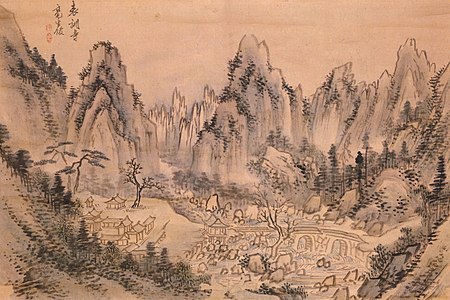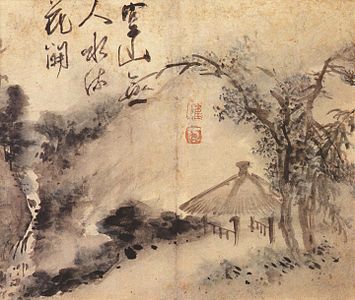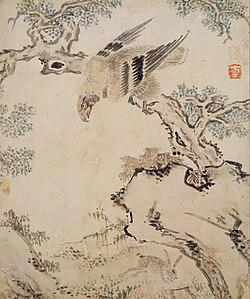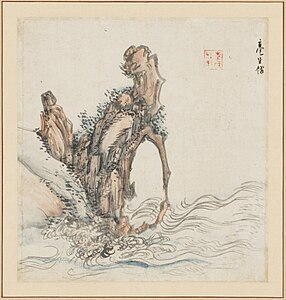Choe Buk
| Choe Buk | |
 | |
| Korean name | |
|---|---|
| Hangul | 최북 |
| Hanja | 崔北 |
| Revised Romanization | Choe Buk |
| McCune–Reischauer | Ch'oe Puk |
| Art name | |
| Hangul | 호생관, 삼기재, 거기재 |
| Hanja | 毫生館, 三奇齋, 居其齋 |
| Revised Romanization | Hosaenggwan, Samgijae, Geogijae |
| McCune–Reischauer | Hosaenggwan, Samgijae, Kŏgijae |
| Courtesy name | |
| Hangul | 성기, 유용 |
| Hanja | 聖器, 有用 |
| Revised Romanization | Seonggi, Yuyong |
| McCune–Reischauer | Sŏnggi, Yuyong |
Choe Buk (Korean: 최북; fl. 1712–1760), was a Korean painter of the late Joseon period. He used many art names including Samgijae, Hosaenggwan, Songjae, Giam, and Geogijae.
Biography
His childhood remains unknown, as well as the social status of his family. The Grove says 'floruit c. 1755–85'.[1]
He was known as a skilled landscape painter, but also drew portraits, flowers and animals. Legend tells of a powerful aristocrat that forced him to draw, but Choe refused to do so and as a result had one eye pierced, leading to the loss sight in that eye.[2]
He was known to have traveled in Japan and was known to Zheng Zhilong's family; painting an image of Zheng's wife and their son Koxinga. The original returned to Korea with Choe, but a copy was kept with the family and was later emulated by Bak Jega.[3]
His living situation became increasingly difficult, so he made a living by wandering around town and selling paintings. On the spot, he drew pictures at the request of others and received money for them, but the price was not set. When a requester offered Choe a small amount of money for one of his fine works, he would become so angry that he would scream and tear up the painting.
However, to those who were willing to pay a lot of money for his low-quality works, Choe mocked them and ordered them to take them immediately, saying: “That fool doesn’t even know the value of paintings."[4]
Style and Galleries
Choe Buk engraved his name and pen name in the center of the painting.[4] He was acquainted with Kim Hong-do, Kim Deuk-sin, Yi In-mun, but his works are dissimilar to theirs.

The Korean Copyright Commission [5] lists 20 paintings for Choe Buk, while Towooart[6] gives a short notice.
- Choe Buk paintings
-
 Pyohun Temple
Pyohun Temple
금강산 표훈사도 -
 Jo-eo Landscape
Jo-eo Landscape
조어산수 -
 Bull riding
Bull riding
맹우도(려우귀가) -
 Cho-ok Landscape
Cho-ok Landscape
초옥산수 -
 A hawk that catches a rabbit
A hawk that catches a rabbit
토끼를 잡아챈 매 (豪鷹博兎圖) -
 Haebyun-giamdo
Haebyun-giamdo
해변기암도 -
 Sansuhwa
Sansuhwa
산수화 -

- Sansudo (Korean: 산수도)
-

-

-

-

-

See also
References
- ^ Turner 2003, p. (07)184
- ^ "Painter Choe Buk". Naenara. May 29, 2020. Retrieved January 7, 2021.
He was good at drawing portraits, landscapes, flowers and animals. He was so skillful in drawing landscapes that he was nicknamed "landscape painter Choe". [...] Poor as he was, he liked drawing beautiful scenery of the country, but he never drew pictures pleasing the feudal ruling circles.
- ^ Park, J.P. (2018). A New Middle Kingdom: Painting and Cultural Politics in Late Chosŏn Korea (1700–1850). University of Washington Press. p. 296. ISBN 978-0295743264.
- ^ a b "LIFE OF A JOSEON GOVERNMENT ARTIST: SOCIAL STATUS, CREATIVE DRIVE AND DRINKING HABITS". National Museum of Korea. January 2012.
- ^ "공유마당 > 이미지검색". gongu.copyright.or.kr. Archived from the original on 3 July 2013. Retrieved 27 January 2022.
- ^ http://www.towooart.com/oldart/old_korea/choibuk/choibuk.htm (in Korean)
Bibliography
- Turner, Jane (2003). Grove Dictionary of Art. Oxford University Press, USA. p. 32600. ISBN 978-0-1951-7068-9.
External links
- Arts of Korea, an exhibition catalog from The Metropolitan Museum of Art Libraries (fully available online as PDF), which contains material on Choe Buk






















